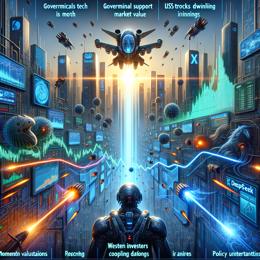Image created by AI
E-Toll Debt Collection Plans Spark Confusion Amid Gauteng Government's Assurances
The lingering quandary over the future of Gauteng's e-toll system and the collection of associated debts from motorists continues to perplex drivers and analysts alike. Despite recent assurances from Gauteng Premier Panyaza Lesufi to terminate the e-tolls, Mampho Modise, Deputy Director-General of Public Finance at National Treasury, has restated the government's intent to pursue outstanding e-toll payments from motorists.
The strategy to collect these debts, however, remains elusive, with details promised to be fleshed out between the Gauteng Provincial Government and the South African National Roads Agency Limited (SANRAL). According to Premier Lesufi, a resolution to disengage e-tolls by March 2024 seemed imminent, contingent upon consensus among stakeholders, including Finance Minister Enoch Godongwana and Transport Minister Sindisiwe Chikunga. Nevertheless, the pathway towards realizing the decommissioning of e-tolls and satisfying the fiscal obligations tied to the Gauteng Freeway Improvement Project (GFIP) is fraught with complexities.
Modise acknowledged the existence of long-standing agreements and highlighted Gauteng's responsibility to decide the approach for the funding of infrastructure. This explicates remarks from Minister Godongwana, who underscored the 70:30 debt distribution arrangement between the national government and Gauteng, alongside Gauteng's commitment to covering GFIP road maintenance.
The potential refund of e-toll payments to compliant motorists has also been bandied about, with contradictory statements muddling the matter further. Lesufi's backpedaling from his initial statement regarding the refund has added to the ambiguity surrounding the e-toll system's future.
Underpinning the discourse is a broader policy alignment where user-pay models are ostensibly upheld by the National Treasury. However, the feasibility of actualizing debt recovery efforts and the technical modalities for execution are pending crystallization. In the interregnum, SANRAL's capacity to maintain service levels without e-toll income poses an additional fiscal puzzle.
Outa CEO Wayne Duvenage has vocalized skepticism about the viability of retrieving e-toll debts, especially given the political landscape and impending elections. Outa's position appears to encourage collective non-compliance as a tactic to enforce the dismantling of the e-toll system prematurely. What persists, as iterated by Duvenage, is the perception of ongoing financial hemorrhage into a controversial and widely repudiated system.
The official standpoint on the outcome of e-tolls is expected to be clarified with the Gauteng MEC for Treasury Jacob Mamabolo's upcoming budget presentation. Until then, the prevalent state of confusion offers no reprieve to motorists, who remain ensnared in a web of bureaucratic non-commitments and inconsistent policies regarding the contentious tolling system. The thorny issue of who will maintain the GFIP roads post e-tolls and who ultimately bears the burden of the debt remains as unsettled as the e-toll gantries themselves.










